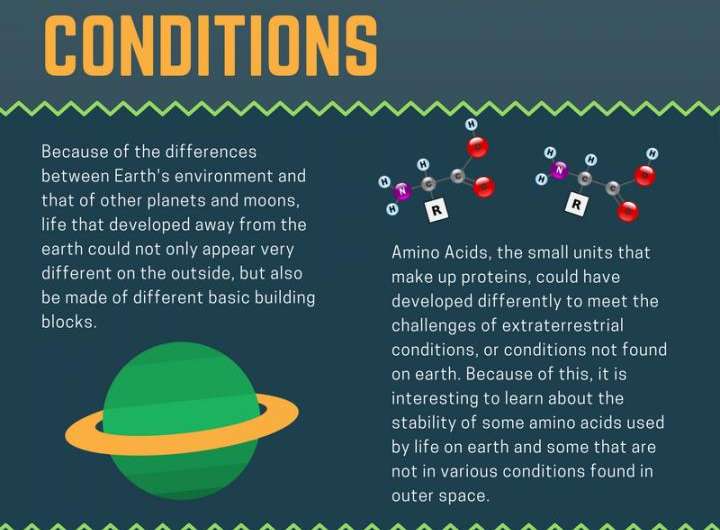In experiments on Earth, testing possible building blocks of alien life

Scientists are attempting to identify the amino acids—building blocks that make proteins and support all life on Earth—that might feasibly form the basis of extraterrestrial life. The researchers have analyzed how an assortment of 15 amino acids, some found here on Earth in living organisms and some not found in living organisms on Earth, hold up in the face of extreme conditions found on other planets and moons.
Claire Mammoser, an undergraduate research assistant in the laboratory of Laura Rowe at Valparaiso University, will present the work at the American Society for Biochemistry and Molecular Biology annual meeting during the Experimental Biology 2017 meeting, to be held April 22-26 in Chicago.
"In a different extraterrestrial locale, the proteins in an organism would not necessarily be the same as that of an organism on Earth, so they might use amino acids that are known to us but not used to make proteins on Earth," said Mammoser. "Our main goal with this research is to see if there are structural characteristics of some amino acids that lead to a higher stability in extraterrestrial conditions and then to see what those characteristics might be."
The team subjects vials of amino acids to extreme temperature, pH, ultraviolet radiation, gamma radiation and other conditions designed to mimic environments on Mars; Enceladus, a moon of Saturn; and Europa, a moon of Jupiter. Tracking the degree to which each amino acid remains intact or breaks down under these conditions, the team looks for patterns in the stability of amino acids with various characteristics, such as large size or the ability to bind with water.
"Finding trends in amino acid stability would give us an idea of what sort of amino acids may have survived in outer space long enough to create life," Mammoser explained.
Now that the team has refined its methods in a preliminary batch of amino acids, it is beginning a new round of experiments using amino acids that have been extracted from meteorites and ones created in origin-of-life experiments going back to the 1950s. They hope the research will help pin down the key characteristics that could foster extraterrestrial life.
"This work is exciting for us because there is not a lot of previous work in this area," said Mammoser. "Often, we are privileged to work on extensions of existing areas of research which have been pioneered by great minds in the field, but this project has been different in that we have done a lot of the initial development ourselves. This is both a challenge and extremely exciting, because there is a sense that we are not just gathering data, but we are also making decisions about the best way to measure amino acid stability in our lab every day."
More information: Experimental Biology 2017 meeting, app.core-apps.com/eb2017/abstr … 2834d471e29e28751e97
Provided by Experimental Biology 2017




















